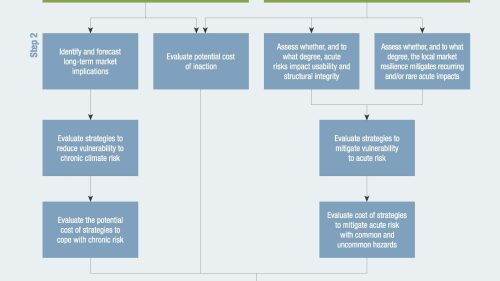Many U.S. cities are developing aggressive sustainability targets. Because the real estate sector accounts for half or more of their carbon emissions, cities are looking for strategies to engage the industry as part of their climate mitigation plans.
One strategy involves use of public/private partnerships to better align the private- and public-sector efforts toward achieving a shared goal. The second ULI City and Real Estate Sustainability Summit, held at the 2018 Fall Meeting in Boston, explored what makes a successful public/private partnership and how the real estate industry has used them in the past. The first summit was held at the 2018 Spring Meeting in Detroit.
“After a successful summit in Detroit, the goal of this follow-up convening was to dive deeper into the combination of technology, incentives, and regulations that will support ULI members, in partnership with their city counterparts locally, to develop innovative and efficient buildings and create more equitable and sustainable cities,” said Marta Schantz, senior vice president of the ULI Greenprint Center for Building Performance.
During the half-day summit, 13 senior ULI members and 12 public policymakers representing various U.S. cities discussed key motivators for both city and real estate sustainability leaders and the value of leveraging financing opportunities to achieve sustainability goals—all with the intent of identifying the best ways to align the public and private goals. Among the policy success stories discussed were:
- The New York State Energy Research and Development Authority (NYSERDA) Real Time Energy Management program, which verifies vendors for energy management systems and funds a portion of such systems, which help optimize building energy use; and
- Fannie Mae’s multifamily Green Rewards program, which provides lower interest rates, up to 5 percent additional loan proceeds, and free audits to finance energy and water efficiency improvements.
To better understand public/private partnerships, summit participants learned about Boston’s own Green Ribbon Commission (GRC). The GRC was founded in 2010 and funded by a coalition of 10 local foundations, and many of its first participants were not climate leaders but business executives—including commercial real estate chief executive officers—with a vested interest in Boston’s long-term success.
For members of the private sector, participation in this group showcases their leadership, provides exposure to city and utility leaders, and educates them on climate risks to the city and their businesses. On the city government side, policymakers have access to an established stakeholder group to provide feedback on upcoming policies, creating momentum for their acceptance when they are released.
This partnership has developed two policy initiatives, Climate Ready Boston, addressing resilience planning, and Carbon Free Boston, which sets Boston on the path toward its 2050 climate targets and creating a cleaner, greener city that attracts top talent for the business community.
“What is unique about the Green Ribbon Commission is that it is a totally voluntary network of 36 leaders representing the key sectors of the Boston economy—commercial real estate, health care, higher education, cultural institutions, utilities, finance, government, and philanthropy—and focused directly on climate action,” said John Cleveland, executive director of the Boston Green Ribbon Commission. “The commission has become a place where civic and business leaders can discuss the long-term implications of climate adaptation and emissions reduction and how successful action on both fronts will reshape the city over the coming decades.”
“I am encouraged by the growing participation among cities to achieve emissions reduction targets, and DWS is committed to doing our part within our own portfolio,” said Jessica Elengical, head of environmental, social, and governance (ESG) strategy, alternatives, for DWS Group, a Europe-based asset management company. “However, as a manager operating in hundreds of cities globally, it can be challenging to negotiate the myriad of regulations and policies that are evolving around this topic. I believe that standardization across cities allows managers to better scale sustainability programming, and it also can help consolidate cities and the industry itself around best practices.”
To continue conversations started at the summits in Detroit and Boston as well as to broaden the impact of this work, the ULI Greenprint Center has begun development of a report titled 10 Principles for Public/Private Partnerships on Climate Mitigation. This report will highlight innovations in public/private partnerships focused on sustainability and identify best practices that facilitate collaboration between the two sectors. Further, it will draw insights from real estate owners/developers and senior city policymakers gained through interviews and an in-person workshop to create a list of 10 principles to support the real estate sector in engaging city policymakers with the goal of achieving value-enhancing climate policy.
“Achieving net carbon neutrality by midcentury in all real estate is simply a necessity if we are to avoid the most catastrophic impacts of climate change, and [this] has become a concrete goal for dozens of cities around the country,” said Brian Swett, principal and director of cities and sustainable real estate for Arup. “Such a transformational change in how we power, heat, and cool our buildings requires collaborative partnership between real estate owners and city officials so that this decarbonization of our built environment occurs in a way that is most economically efficient.”
To get involved in ULI’s future work engaging cities to ensure practical solutions to the climate challenge, either by participating in upcoming in-person summits or submitting an example of successful public/private partnerships to advance climate mitigation, visit ULI Navigator.




